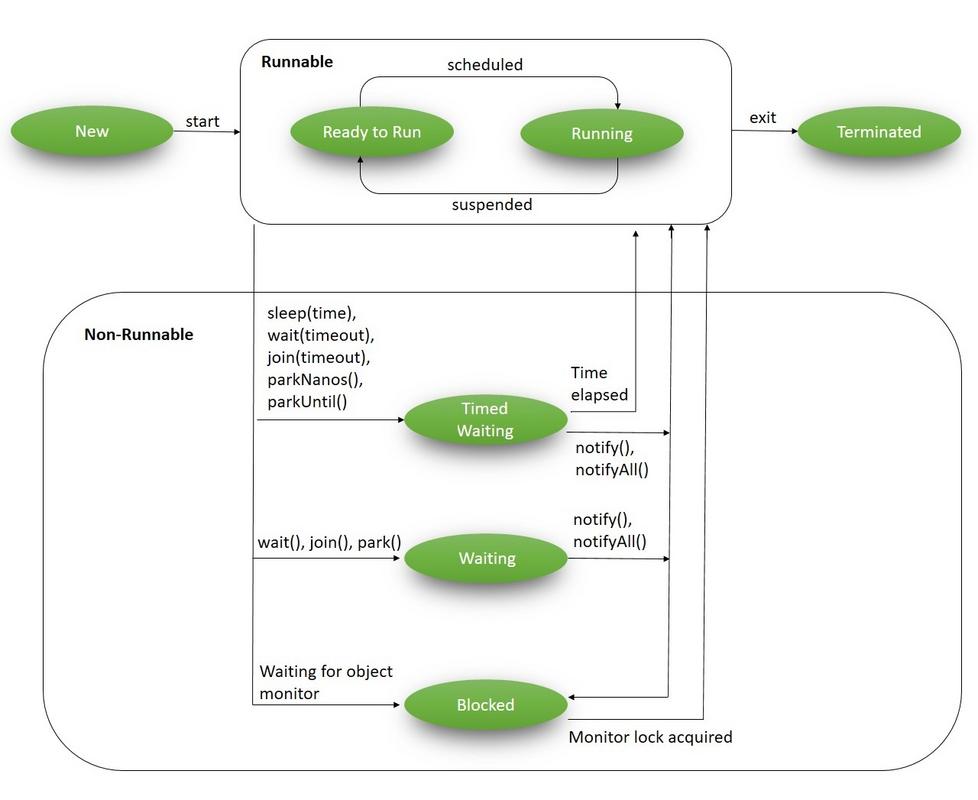Java - Thread Life Cycle 線程生命週期
Overview
In the Java language, multithreading is driven by the core concept of a Thread. During their lifecycle, threads go through various states:

Ref: Life Cycle of a Thread in Java - Baeldung
Life Cycle of a Thread
The java.lang.Thread class contains a static State enum – which defines its potential states.
During any given point of time, the thread can only be in one of these states:
- NEW: newly created thread that has not yet started the execution
- RUNNABLE: either running or ready for execution but it’s waiting for resource allocation
- BLOCKED: waiting to acquire a monitor lock to enter or re-enter a synchronized block/method
- WAITING: waiting for some other thread to perform a particular action without any time limit
- TIMED_WAITING: waiting for some other thread to perform a specific action for a specific period
- TERMINATED: has completed its execution
New
當線程對象創建後,並且尚未啟動線程,即進入新建狀態,直到使用
start()方法啟動它為止。
Runnable runnable = new NewState();
Thread t = new Thread(runnable);
log.info(t.getState());
console:
NEW
Runnable
當調用線程對象的
start()方法時,線程即進入就緒狀態(RUNNABLE)。處於就緒狀態的線程只是說明此線程已經做好準備, 隨時等待CPU調度執行,並不是說執行了start()方法就立刻執行。
In a multi-threaded environment, the Thread-Scheduler (which is part of JVM) allocates a fixed amount of time to each thread. So it runs for a particular amount of time, then relinquishes the control to other RUNNABLE threads.
在多線程環境中,線程調度程序(JVM的一部分)為每個線程分配固定的時間量。因此它運行特定的時間,然後將控件放棄給其他RUNNABLE線程。
Runnable runnable = new NewState();
Thread t = new Thread(runnable);
t.start();
log.info(t.getState());
console:
RUNNABLE
Blocked
處於運行狀態(RUNNABLE)的線程由於某種原因,暫時放棄對CPU的使用權,停止執行,此時進入阻塞狀態,知道其進入到就緒狀態,才有機會再次被CPU調用以進入到運行狀態。
阻塞狀態分類
- 等待阻塞:運行狀態中的線程執行
wait()方法,使本線程進入到等待阻塞狀態- 線程在獲取
synchronized同步鎖失敗(因為鎖被其它線程佔用),它會進入到同步阻塞狀態- 其它阻塞:通過調用線程的
sleep()或join()或發出I/O請求時,線程會進入到阻塞狀態。 當sleep()狀態超時、join()等待線程終止或者超時、或者I/O處理完畢時,線程重新轉入就緒狀態。
public class BlockedState {
public static void main(String[] args) throws InterruptedException {
Thread t1 = new Thread(new DemoThreadB());
Thread t2 = new Thread(new DemoThreadB());
t1.start();
t2.start();
Thread.sleep(1000);
System.out.println(t2.getState());
System.exit(0);
}
}
class DemoThreadB implements Runnable {
@Override
public void run() {
commonResource();
}
public static synchronized void commonResource() {
while (true) {
// Infinite loop to mimic heavy processing 't1'
// won't leave this method
// when 't2' try to enters this
}
}
}
- 我們創建了兩個不同的線程–
t1和t2 t1開始並進入同步的commonResource()方法;這意味著只有一個線程可以訪問它;嘗試訪問此方法的所有其他後續線程將被阻止進一步執行,直到當前線程將完成處理為止- 當
t1進入此方法時,它會無限循環。這只是為了模仿繁重的處理,以便所有其他線程無法進入此方法 - 現在,當我們啟動t2時,它將嘗試輸入
commonResource()方法,該方法已被t1訪問,因此,t2將保持在BLOCKED狀態
console:
BLOCKED
Waiting
A thread is in WAITING state when it’s waiting for some other thread to perform a particular action. According to JavaDocs, any thread can enter this state by calling any one of following three methods:
Object.wait()thread.join()LockSupport.park()
public class WaitingState implements Runnable {
public static Thread t1;
public static void main(String[] args) {
t1 = new Thread(new WaitingState());
t1.start();
}
@Override
public void run() {
Thread t2 = new Thread(new DemoThreadWS());
t2.start();
try {
t2.join();
} catch (InterruptedException e) {
Thread.currentThread().interrupt();
System.out.println("Thread interrupted: " + e);
}
}
}
class DemoThreadWS implements Runnable {
@Override
public void run() {
try {
Thread.sleep(1000);
} catch (InterruptedException e) {
Thread.currentThread().interrupt();
System.out.println("Thread interrupted: " + e);
}
System.out.println(WaitingState.t1.getState());
}
}
- 我們已經創建並啟動了
t1 t1創建一個t2並啟動它- 在繼續執行
t2的過程中,我們調用t2.join(),這會將t1置於WAITING狀態,直到t2完成執行 - 由於
t1等待t2完成,因此我們從t2調用t1.getState()
console:
WAITING
Timed Waiting
A thread is in TIMED_WAITING state when it’s waiting for another thread to perform a particular action within a stipulated amount of time.
According to JavaDocs, there are five ways to put a thread on TIMED_WAITING state:
- thread.sleep(long millis)
- wait(int timeout) or wait(int timeout, int nanos)
- thread.join(long millis)
- LockSupport.parkNanos
- LockSupport.parkUntil
public class TimedWaitingState {
public static void main(String[] args) throws InterruptedException {
DemoThread obj1 = new DemoThread();
Thread t1 = new Thread(obj1);
t1.start();
// The following sleep will give enough time for ThreadScheduler
// to start processing of thread t1
Thread.sleep(1000);
System.out.println(t1.getState());
}
}
class DemoThread implements Runnable {
@Override
public void run() {
try {
Thread.sleep(5000);
} catch (InterruptedException e) {
Thread.currentThread().interrupt();
System.out.println("Thread interrupted: " + e);
}
}
}
在這裡,我們創建並啟動了線程t1,該線程進入睡眠狀態的超時時間為5秒。
console:
TIMED_WAITING
Terminated
This is the state of a dead thread. It’s in the TERMINATED state when is has either finished execution or was terminated abnormally.
In this article: (How to Kill a Java Thread that discusses different ways of stopping the thread.
public class TerminatedState implements Runnable {
public static void main(String[] args) throws InterruptedException {
Thread t1 = new Thread(new TerminatedState());
t1.start();
// The following sleep method will give enough time for
// thread t1 to complete
Thread.sleep(1000);
System.out.println(t1.getState());
}
@Override
public void run() {
// No processing in this block
}
}
在這裡,當我們啟動線程t1下一個語句Thread.sleep(1000)為t1完成提供了足夠的時間,因此該程序將輸出顯示為:
TERMINATED